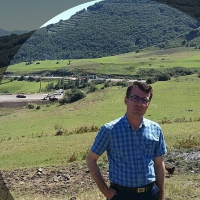Determining Changes in Water and Energy Balance in Different Time Scales Using Budyko Curve in the Nir Watershed, Ardabil
Introduction and Goal:
In hydrological and water resources studies, the understanding of water balance components and changes holds great significance. Climate changes and human activities affect runoff changes, water resources management and sustainable development of society. In this regard, the current research was conducted with the aim of determining and comparing water balance changes using Budyko curve in Nir watershed, Ardabil province.
The Budyko curve was calculated for the Nair watershed in monthly, seasonal and annual time scales. In this study, the data of the rain gauge and evapotranspiration station of the watershed were also used in a statistical period of 33-years to calculate the average precipitation and evapotranspiration potential in the watershed. In the Budyko curve, the non-linear relationship that is limited by the physical limits of atmospheric water demand (PET>ET) and supply (P>ET) and the aridity index in the Budyko curve show the long-term water balance.
The results showed that, the trend of flow changes is directly related to the trend of weather components in annual time scale. Meanwhile, contrary to expectation, only in some seasons does the flow change process follow the change in climatic components. In addation, the Budyko curve analysis indicated that the amount of water consumption in the studied watershed regularly deviated from its predicted dependence on energy and water balance. The maximum, average and minimum ET for the studied years were obtained as 876.55, 431.85 and 277.88, respectively. Also, the maximum, average and minimum ratio of PET/P was 0.07, 0.05 and 0.02 respectively. In most of the years studied, the observational data aligned with the water limit range on the Budyko curve, indicating that the observed water consumption (AET/P) matched the predicted water consumption (PET/P). According to the results, the changes in AET/P are less in the years (1981, 1983, 1989, 1994, and 2010). Based on the changes in the values of PET/P and AET/P in the Budyko curve, the watershed ability to regulate AET can be considerable.
Conclusions and Suggestions:
The results of this study indicated that with increased temperature and decreased precipitation, the annual actual evapotranspiration of the watershed increased, leading to a reduction in runoff. The results can be the basis for providing management solutions and adapting to the climate change in order to optimally use the available water resources. In general, it can be said that the amount of potential evaporation in the studied watershed is more than the amount of precipitation. The study's findings can provide a basis for managing water resources under the limitations of climate change and human abstractions.
-
Analysing the Quality Karaj City Green Spaces using Remote Sensing Ecological Index (RSEI)
Nazanin Naseri, Milad Hosseinzadeh Niri, *
Journal of Geography and Environmental Studies, Spring 2025 -
Determining the dynamics of land use changes in a long-term time span in Erzurum, Turkey
, Memet Salih Bayraktutan *,
Anthropogenic Pollution Journal, Summer and Autumn 2024 -
Assessment and Optimization of Hydrological Connectivity for Effective Management of Water Resources in the Samian Watershed
Zeinab Hazbavi *,
spatial planing, -
Analysis the relationship between the changes of hydrological components and landscape metrics under rainfall simulation and rangeland vegetation of Ardabil Province
Mahin Kalehhouei, , Abazar Esmali Ouri, Rahmani Naneh Karan, Fardin, Fazeli, Alireza, , Zeinab Hazbavi *
Journal of Watershed Engineering and Management, -
Determining Community Attitudes toward Various Aspects of the COVID-19 Pandemic Using the Social Profile Ratio Technique
, Fahimeh Mirchooli, *
Journal of Human Environment and Health Promotion, Winter 2024 -
The Concept of Policy Profile Ratio (PPR) in Determining Stakeholders’ Attitudes to Changing Agriculture and Natural Resources Practices
, Abazar Esmaliouri *, , Mearaj Sharari, Zeinab Hezbawi
Human & Environment,





